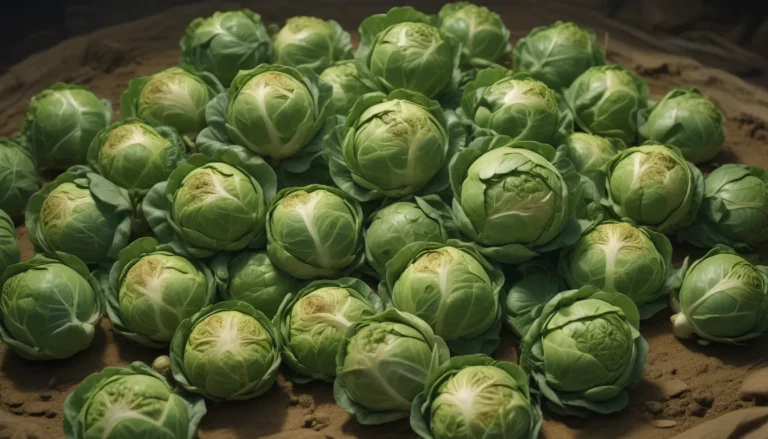A Comprehensive Guide to Identifying and Controlling Walnut Husk Flies

Walnuts are truly a delightful addition to any garden or orchard, offering not only their beauty and shade but also their nutritious nuts and valuable wood. However, the presence of walnut husk flies can quickly turn this idyllic scenario into a nightmare for growers. These tiny insects, measuring just 1/4 inch in length, can wreak havoc on walnut trees, leading to significant damage and potential crop loss.
In this detailed guide, we will explore everything you need to know about identifying and controlling walnut husk flies. From understanding their life cycle and distribution to implementing effective monitoring and control strategies, we’ve got you covered. So grab a cup of coffee, sit back, and let’s dive into the fascinating world of walnut pest management.
What You Will Discover
- Identification, Life Cycle, and Distribution
- Susceptible Walnut Species and Cultivars
- Current Spread of Walnut Husk Flies
- Impact on Walnut Trees
- Monitoring Adult Walnut Husk Flies
- Effective Control Strategies
Identification, Life Cycle, and Distribution
The walnut husk fly, scientifically known as Rhagoletis completa, possesses distinctive features that make it relatively easy to identify. These insects are approximately the size of a housefly, with a brown body adorned with a yellow semicircle on the back. Moreover, their translucent wings, characterized by large brownish-black bands, further contribute to their unique appearance.
Adult walnut husk flies typically emerge from the soil between May and early fall, engaging in mating activities within 1-2 weeks. Subsequently, females lay eggs just beneath the surface of the walnut husk, giving rise to white maggots within 5-7 days. These larvae feed on the flesh of the husk, progressively causing damage that may range from shell discoloration to kernel destruction.
Originating in the southern and central United States, walnut husk flies have gradually spread to the West Coast, becoming a significant concern for walnut growers in regions like California and Washington State. English walnut cultivars, such as Franquette, Hartley, Serr, and Tulare, are particularly vulnerable to infestations by these pests.
Susceptible Walnut Species and Cultivars
Different walnut species and cultivars exhibit varying degrees of susceptibility to walnut husk flies. Black walnuts and all cultivars of English walnut are preferred hosts for these insects, with certain cultivars, such as Hartley, Payne, and Serr, being especially prone to early-season attacks.
Understanding the susceptibility of the walnut species and cultivars in your orchard can help you devise targeted pest management strategies to mitigate potential damage.
The Walnut Husk Fly is Spreading!
According to experts, the walnut husk fly is expanding its range and becoming a concern in new areas previously unaffected by this pest. Climate change and environmental factors may be contributing to the accelerated arrival of these flies, necessitating earlier monitoring and control measures.
Stay vigilant and adapt your pest management practices to accommodate the evolving behavior of walnut husk flies in your region.
Effects on Walnuts
The extent of damage caused by walnut husk flies can vary depending on the timing of infestations. Early attacks during nut development stages can result in significant damage to the kernels and potential crop loss. In contrast, later infestations may lead to shell staining, rendering in-shell nuts unsuitable for sale while preserving kernel quality.
Identifying and addressing infestations promptly is crucial to minimizing damage and preserving the overall health of your walnut crop.
How to Monitor Adult Walnut Husk Flies
Monitoring adult walnut husk flies is a key element of effective pest management. Since eggs and larvae are concealed within the husk, focusing on adult flies provides crucial insights into the presence and activity of these insects. By utilizing yellow sticky traps, growers can detect and monitor adult flies, allowing for timely intervention before significant damage occurs.
Follow these steps to monitor adult walnut husk flies effectively:
- Place unbaited yellow sticky traps, enhanced with ammonium carbonate, in the upper canopy of trees.
- Monitor traps regularly, ideally twice a week, to detect adult flies.
- Identify female flies, distinguished by yellow front legs, and check for eggs before they are laid.
- Act promptly upon detecting adult flies to prevent egg laying and larval infestations.
Adopting proactive monitoring practices can help you stay ahead of walnut husk fly infestations and protect your crop from potential damage.
Control Strategies
Combatting walnut husk flies requires a combination of monitoring and control measures to safeguard your walnut trees effectively. Implementing timely and targeted control strategies can help mitigate infestations and preserve the health and productivity of your orchard.
Organic Insecticide/Bait
Organic insecticides, such as GF-120 containing natural insecticide spinosad, coupled with bait attractants, offer a sustainable and environmentally friendly control option. Start spraying as soon as adult flies are detected to effectively target and eliminate the pest population.
Conventional Insecticide/Bait
In cases of severe infestations, conventional insecticides mixed with bait can provide immediate control of walnut husk flies. Monitor fly populations and adjust your control strategy based on the extent of infestation to achieve optimal results while minimizing environmental impact.
Effective Insecticides for Walnut Husk Fly Control:
- Acetamiprid (effective for 14 days)
- Bifenthrin (effective for 21-28 days)
- Beta-cyfluthrin (effective for 14 days)
- Lambda-cyhalothrin (effective for 14 days)
Choose insecticides that target adult flies while minimizing adverse effects on beneficial insects and the environment.
Inspect Your Walnuts for Stings
Identifying stings caused by walnut husk fly oviposition is a critical step in assessing infestation severity and determining the need for control measures. Look for characteristic teardrop-shaped stains on walnut husks, indicating active egg laying by female flies.
Regular inspections of walnuts for stings can provide valuable insights into pest activity and guide your pest management decisions effectively.
Sanitation in the Fall
Practicing good sanitation measures in the fall can help prevent the spread of walnut husk fly larvae and reduce subsequent infestations. Use tarps to collect fallen walnuts containing maggots and dispose of infested nuts properly to prevent reinfestation.
Maintaining a clean and pest-free environment around your walnut trees is essential for minimizing pest pressure and preserving crop quality.
Selectively Harvest Your Walnuts
When harvesting walnuts, exercise caution and selectively pick fresh, undamaged nuts while avoiding darker, potentially infested ones. Promptly de-husk walnuts to remove potential breeding sites for walnut husk flies and monitor fallen walnuts for signs of infestation.
By selectively harvesting walnuts and monitoring infested nuts, you can protect your crop and reduce the risk of future infestations.
Monitoring the Flies is Critical For a Healthy Crop
In conclusion, walnut husk flies pose a significant threat to walnut trees, necessitating proactive monitoring and effective control measures to safeguard your orchard. By understanding the life cycle, behavior, and preferred hosts of these pests, you can develop targeted pest management strategies to mitigate damage and protect your walnut crop.
Engage in regular monitoring, implement timely control measures, and stay informed about the latest developments in walnut husk fly management to ensure a healthy and productive harvest season. Remember, early detection and intervention are key to preventing extensive damage and preserving the quality of your walnuts.
Share your experiences and insights on combating walnut husk flies in the comments below. Your feedback and tips may help fellow growers tackle this common pest and achieve successful walnut cultivation.
Conclusion
In this detailed guide, we’ve explored the ins and outs of identifying and controlling walnut husk flies, offering valuable insights and practical tips for effective pest management. Whether you’re a seasoned walnut grower or a novice orchard enthusiast, understanding the behavior and lifecycle of these pests is essential for protecting your crop and ensuring a bountiful harvest.
By adopting proactive monitoring practices, utilizing targeted control strategies, and staying informed about the latest pest management techniques, you can successfully combat walnut husk flies and enjoy healthy, thriving walnut trees. Remember, knowledge is power when it comes to pest control, so arm yourself with information and tools to safeguard your orchard against these pesky invaders.
Here’s to a fruitful walnut season filled with delicious nuts and thriving trees! Happy growing!





